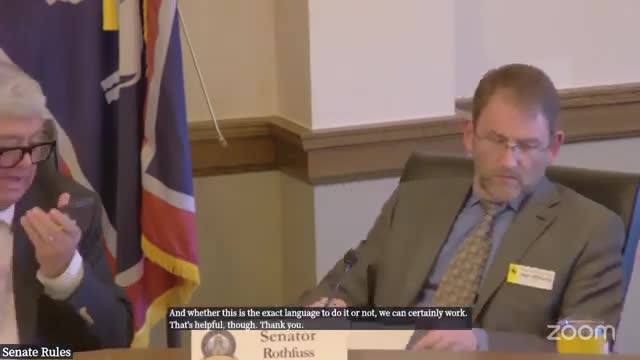Committee examines rules tied to House Bill 158 to add push-button electronic voting; senators voice concerns about transparency and 'ghost voting'
This article was created by AI summarizing key points discussed. AI makes mistakes, so for full details and context, please refer to the video of the full meeting. Please report any errors so we can fix them. Report an error »

The Senate Rules Committee reviewed proposed rule changes that would take effect only if House Bill 158 — which would create a push-button electronic voting system for both chambers and provide an appropriation for installation — is enacted and the system is operational before the 2026 session.
LSO staff explained how the Legislature's current roll-call web page works: when the chief clerk records a roll-call vote, the page lists the motion and shows each senator's name change to a color and an initial (for example, green with "Y" for aye) in real time as votes are entered. Staff said there is currently no permanent public record of interim screenshots; the official record is the chief clerk's final entry for the roll-call.
The proposed rules tied to HB 158 would expand the number of recorded votes to "everything except" a short list of motions (including adjourn, recess, re-refer, recommit, previous question, withdraw). Under the draft, most motions would have a fixed time (one minute) for members to cast votes electronically; the consent list would have a 32-second reconsideration option. LSO said the change would increase recorded votes during floor action beyond the existing set of recorded votes.
Senators expressed mixed reactions. Supporters, including Senator Larson, said a push-button system could modernize voting and reduce time on certain votes. Larson said, "I just wanna keep it in everybody's vision that, I would like to have a push button voting system." Opponents raised concerns that expanding recorded votes could enable third parties to capture and repurpose interim vote data and that push-button voting could encourage "ghost voting," where absent members' votes are cast by proxies or others at their desks.
Chief Clerk Ellen (identified by staff) and others discussed timing: a manual roll call currently can take under a minute; House clerk Katie Talbot's roll-call timing was quoted as 1½ to just over 2 minutes depending on vote variability. LSO noted increased recorded votes would require system features and staffing considerations. Committee members did not adopt the contingent rules at the meeting and asked for further study of trade-offs between immediacy, public transparency, and preserving floor deliberation.
LSO staff explained how the Legislature's current roll-call web page works: when the chief clerk records a roll-call vote, the page lists the motion and shows each senator's name change to a color and an initial (for example, green with "Y" for aye) in real time as votes are entered. Staff said there is currently no permanent public record of interim screenshots; the official record is the chief clerk's final entry for the roll-call.
The proposed rules tied to HB 158 would expand the number of recorded votes to "everything except" a short list of motions (including adjourn, recess, re-refer, recommit, previous question, withdraw). Under the draft, most motions would have a fixed time (one minute) for members to cast votes electronically; the consent list would have a 32-second reconsideration option. LSO said the change would increase recorded votes during floor action beyond the existing set of recorded votes.
Senators expressed mixed reactions. Supporters, including Senator Larson, said a push-button system could modernize voting and reduce time on certain votes. Larson said, "I just wanna keep it in everybody's vision that, I would like to have a push button voting system." Opponents raised concerns that expanding recorded votes could enable third parties to capture and repurpose interim vote data and that push-button voting could encourage "ghost voting," where absent members' votes are cast by proxies or others at their desks.
Chief Clerk Ellen (identified by staff) and others discussed timing: a manual roll call currently can take under a minute; House clerk Katie Talbot's roll-call timing was quoted as 1½ to just over 2 minutes depending on vote variability. LSO noted increased recorded votes would require system features and staffing considerations. Committee members did not adopt the contingent rules at the meeting and asked for further study of trade-offs between immediacy, public transparency, and preserving floor deliberation.
View full meeting
This article is based on a recent meeting—watch the full video and explore the complete transcript for deeper insights into the discussion.
View full meeting